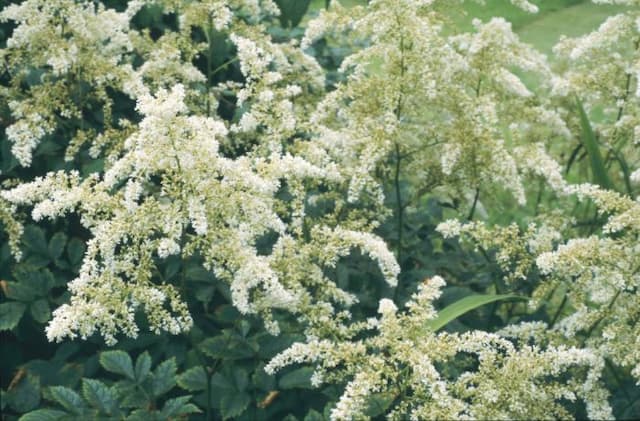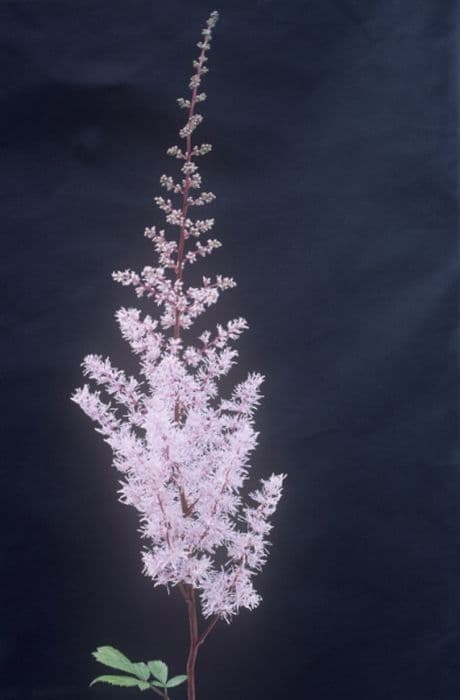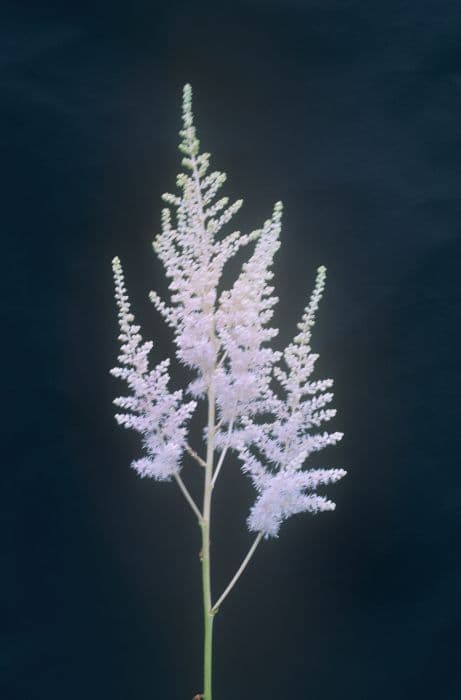Foamy Bells × Heucherella 'Sweet Tea' (PBR)

ABOUT
× Heucherella 'Sweet Tea' is an ornamental hybrid plant known for its striking foliage and hardiness. The leaves of 'Sweet Tea' are the most eye-catching feature. They are large and heart-shaped, showcasing a unique coloration that changes with the seasons. Starting in spring, the leaves exhibit an orangey-copper tone, with each leaf darkening to a rich, cinnamon-brown shade as it matures. The centers of the leaves often have a decorative pattern that stands out with its darker burgundy tone, giving it a dramatic and contrasting appearance. In addition to the warm, earth-toned foliage, this plant produces sprays of delicate, small flowers. The flowers are usually a soft, creamy white color, which stands out beautifully against the dark leaves. These blossoms can add a light, airy quality to the plant as they adorn the clumping foliage beneath. Overall, 'Sweet Tea' is especially admired for its multicolored leaves that bring a vibrant and interesting texture to gardens. It is often used as a groundcover or featured in garden borders for its dynamic appearance.
About this plant
 Names
NamesFamily
Saxifragaceae
Synonyms
Foamy Bells, Sweet Tea Heucherella
Common names
× Heucherella 'Sweet Tea' (PBR).
 Toxicity
ToxicityTo humans
Heucherella 'Sweet Tea' is not commonly known to be toxic to humans. In general, Heucherella species, which is a cross between Heuchera and Tiarella, are not associated with serious health risks upon ingestion. However, as with any plant, individual allergic reactions or sensitivities to Heucherella 'Sweet Tea' could potentially occur. Accidental ingestion might result in mild gastrointestinal discomfort in some people, although such cases are not commonly reported. It is always advisable to prevent the ingestion of any plant material that is not known to be edible and to consult a medical professional if you suspect poisoning.
To pets
Heucherella 'Sweet Tea' is not commonly known to be toxic to pets. This hybrid plant, a cross between two genera that are not noted for their toxicity, does not typically pose a threat to animals if ingested. However, as with any non-food plant, consumption of Heucherella 'Sweet Tea' might result in mild gastrointestinal upset in some pets due to the unique sensitivity of their digestive systems or as a simple mechanical reaction to eating non-digestible matter. It is always best to prevent pets from ingesting plants and to consult a veterinarian if you suspect your pet has ingested a potentially harmful substance.
 Characteristics
CharacteristicsLife cycle
Perennials
Foliage type
Evergreen
Color of leaves
Mixed
Flower color
White
Height
1-2 feet (0.3-0.6 meters)
Spread
1-2 feet (0.3-0.6 meters)
Plant type
Herb
Hardiness zones
4-9
Native area
North America
Benefits
 General Benefits
General Benefits- Ornamental Appeal: Foamy Bells 'Sweet Tea' is sought after for its decorative foliage that brings striking color and texture to gardens and landscapes.
- Drought Tolerance: Once established, it is moderately drought tolerant, reducing the need for frequent watering.
- Low Maintenance: This plant has minimal maintenance requirements, making it ideal for gardeners looking for low-care landscape options.
- Shade Tolerance: It thrives in partial shade, making it a suitable choice for underplanting and shaded gardens.
- Seasonal Interest: Foamy Bells 'Sweet Tea' displays seasonal changes in leaf color, providing year-round interest in the garden.
- Attracts Wildlife: The flowers of Foamy Bells can attract beneficial insects such as bees, providing a habitat and food source for local fauna.
- Soil Versatility: It can adapt to a variety of soil conditions as long as the soil is well-drained.
- Container Planting: With its mounding habit, it makes an excellent choice for containers and hanging baskets.
- Border Plant: Its size and form make it ideal for use as a border plant in garden beds and paths.
 Medical Properties
Medical PropertiesThis plant is not used for medical purposes.
 Air-purifying Qualities
Air-purifying QualitiesThis plant is not specifically known for air purifying qualities.
 Other Uses
Other Uses- Craft Projects: Leaves from Heucherella can be pressed and dried to be used in crafting, such as creating personalized bookmarks or in floral arrangements.
- Insect Habitat: The foliage of Heucherella provides shelter for beneficial insects, promoting biodiversity in the garden.
- Educational Tool: Gardeners and educators can use Heucherella to demonstrate hybridization and cross-breeding techniques in plants.
- Artistic Inspiration: The unique patterns and colors of Heucherella leaves can serve as a source of inspiration for artists, especially in botanical illustration.
- Photography Subject: The distinctive appearance of Heucherella makes it an excellent subject for photographers specializing in plant and macro photography.
- Color Palette Guide: Designers can use the rich hues of Heucherella 'Sweet Tea' as a natural color palette for interior or graphic design.
- Theme Gardens: Heucherella can be included in theme gardens, such as tea-themed gardens, due to its name associating with 'Sweet Tea'.
- Garden Sculpture: Larger Heucherella plants can be used to create a 'living sculpture' in the garden when grown in specific shapes or patterns.
- Container Accents: Planted in decorative pots, Heucherella adds aesthetic value and can be used as living decor on balconies or patios.
- Frost Art: In colder climates, frost on Heucherella leaves can create beautiful, natural art that can be appreciated during the chilly months.
Interesting Facts
 Feng Shui
Feng ShuiThe Heucherella is not used in Feng Shui practice.
 Zodiac Sign Compitability
Zodiac Sign CompitabilityThe Heucherella is not used in astrology practice.
 Plant Symbolism
Plant Symbolism- Endurance: As a cross between two hardy perennials, Heucherella (a cross of Heuchera and Tiarella) symbolizes the ability to endure challenging conditions and thrive.
- Adaptability: This plant's versatility in various garden settings represents adaptability to different life situations.
- Protection: With its lush foliage, Heucherella is often thought to symbolize a protective nature, offering shelter and sustenance to various forms of wildlife.
 Water
WaterThe Foamy Bells 'Sweet Tea' requires consistent moisture, so it should be watered thoroughly whenever the top inch of the soil feels dry. This typically means watering about once a week, but frequency can vary depending on climate, season, and indoor conditions. Always check the soil moisture level before watering. When it's time to water, pour water slowly at the base of the plant until it begins to drain from the bottom of its container, ensuring you wet the entire root ball. An average might be around 16-32 ounces per week, but this can vary significantly with environmental conditions, so it is crucial to adjust based on the plant's needs.
 Light
LightFoamy Bells 'Sweet Tea' thrives in partial shade to full shade locations, where it can receive filtered or dappled sunlight. The best spot is one where morning sun is available but shelter from the intense afternoon sunlight is provided. Indoors, place it near a north-facing window or slightly away from a brighter window with a sheer curtain to diffuse strong light.
 Temperature
TemperatureFoamy Bells 'Sweet Tea' grows best in temperatures between 60 and 80 degrees Fahrenheit. It can survive minimum temperatures down to about 20 degrees Fahrenheit, but a hard frost may damage the foliage. The plant enjoys cooler night temperatures, so if grown indoors, ensure the room doesn't become excessively warm at night.
 Pruning
PruningFoamy Bells 'Sweet Tea' should be pruned to remove dead or damaged leaves and to promote a tidy growth habit. Pruning is best done in early spring or after the plant has finished flowering. If the plant becomes leggy or the foliage is old and tattered, cut it back by about one third. This will encourage new growth and maintain a compact, healthy appearance.
 Cleaning
CleaningAs needed
 Soil
SoilFoamy Bells 'Sweet Tea' thrives best in well-draining, humus-rich soil with a pH range of 5.5 to 6.5. The ideal soil mix can be created by combining equal parts of garden soil, peat moss, and perlite or coarse sand to ensure proper drainage and aeration. Regularly amending the soil with organic compost will enrich nutrient content and support vigorous growth.
 Repotting
RepottingFoamy Bells 'Sweet Tea' should be repotted every 2-3 years, or when it outgrows its current pot. Gently loosen the root ball and transfer to a slightly larger pot with fresh soil mix to encourage continued health and growth.
 Humidity & Misting
Humidity & MistingFoamy Bells 'Sweet Tea' prefers moderate humidity levels. Consistently maintaining humidity around 50% is ideal for this plant, avoiding environments that are too dry or excessively humid, which can provoke stress or disease.
 Suitable locations
Suitable locationsIndoor
Ensure bright indirect light and moderate humidity for Foamy Bells.
Outdoor
Plant in partial shade with moist, well-drained soil for Foamy Bells.
Hardiness zone
4-9 USDA
 Life cycle
Life cycleThe Foamy Bells 'Sweet Tea' commences its life cycle with seed germination, which requires a moist environment and specific temperature conditions to sprout. The seedlings then develop into young plants, sporting their characteristic foliage which will mature over time. As the plant matures, it establishes a strong root system and produces larger, distinctive leaves known for their unique bronze-orange color in spring and autumn, and deeper tones in summer. This perennial reaches full maturity within 2-3 years, at which point the Foamy Bells 'Sweet Tea' begins its reproductive stage, blooming in late spring to early summer with small, white, bell-shaped flowers that attract pollinators. After the blooming season, seeds are produced, and once they are dispersed, the plant enters a period of dormancy during colder months while the foliage may die back, especially in harsher climates. With the arrival of favorable conditions in spring, the plant exits dormancy, regrows if necessary, and the cycle repeats.
 Propogation
PropogationPropogation time
Spring to early summer
The most popular method for propagating x Heucherella 'Sweet Tea', also known as foamy bells, is by division. This is best done in the spring as the plant emerges from dormancy, when the temperatures are mild and the soil is moist, to help the divisions establish. To propagate by division, carefully dig up the clump of the parent foamy bells plant and gently tease apart the crown to separate it into smaller sections, ensuring that each division has a healthy portion of roots and a few shoots. These divisions can then be replanted immediately into a prepared area of the garden or into pots with well-draining soil. It's important to maintain consistent moisture after planting until the new plants are established, which usually takes several weeks.









